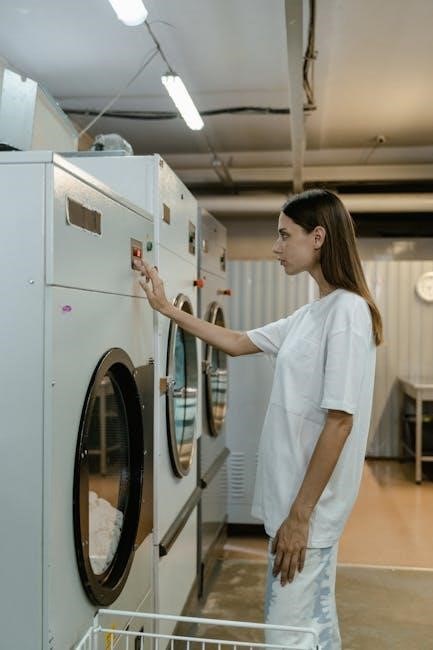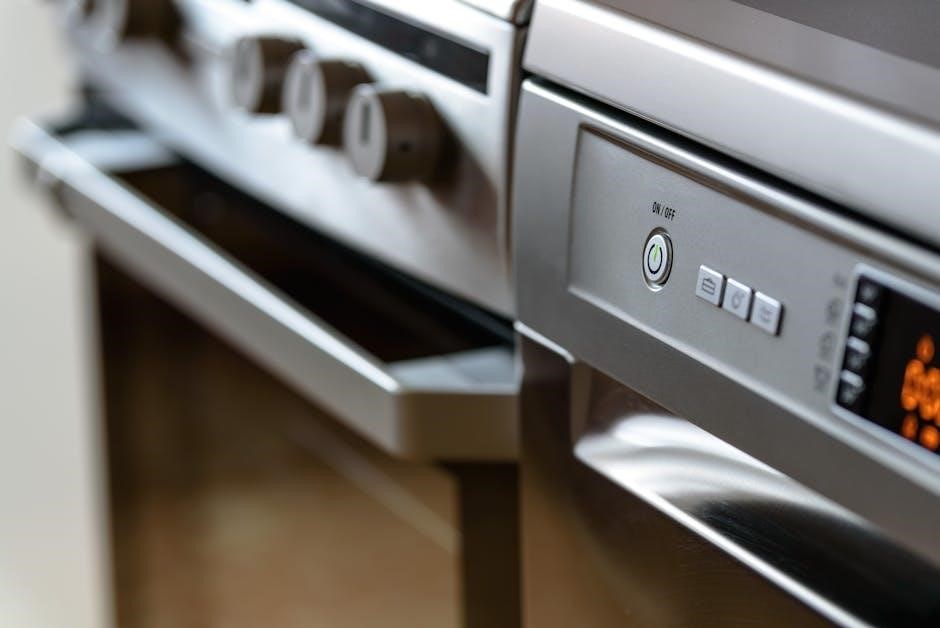Understanding the basics of GE self cleaning oven instructions is crucial for proper usage and maintenance of the oven, using online resources effectively always.
Preparation for Self-Cleaning
To prepare for self-cleaning, remove the broiler pan, grid, and other cookware from the oven. Wipe up excess spillage before starting the self-cleaning operation. Check the oven for any large food debris and remove it to minimize smoke. Ensure the oven is empty and clean before starting the self-cleaning cycle. Proper preparation is essential for effective self-cleaning and to prevent any damage to the oven. By following these steps, you can ensure a safe and successful self-cleaning process. It is also important to refer to the specific instructions for your oven model to determine the best preparation method. This will help you to get the most out of your self-cleaning oven and keep it in good working condition.
Using the Self-Clean Feature on a GE Oven
Start by removing pans and racks from the oven completely always.
Removing Items from the Oven
To prepare the oven for self-cleaning, it is essential to remove all items from the oven, including racks, pans, and any other cookware. This step is crucial to ensure that the self-cleaning process is effective and safe. Remove any large food debris from the oven to minimize smoke and fumes during the cleaning cycle. Additionally, wipe up any excess spillage or food residue from the oven surfaces to prevent them from becoming baked on during the self-cleaning process. By removing all items and cleaning up any debris, you can help ensure a successful self-cleaning cycle and maintain the overall performance of your oven. Proper removal of items is necessary for effective cleaning.

Locking the Oven Door
Lock the oven door to prevent accidental opening during the cleaning cycle always using the door lock mechanism provided by the manufacturer safely.
Preventing Accidental Opening
To prevent accidental opening of the oven door during the self-cleaning cycle, it is essential to lock the door securely using the lock mechanism provided. This ensures that the door remains closed throughout the cleaning process, preventing any potential accidents or injuries. The lock mechanism is designed to withstand the high temperatures generated during the self-cleaning cycle, providing an added layer of safety and security. By locking the oven door, users can have peace of mind knowing that the self-cleaning cycle is running safely and efficiently, without any risk of accidental opening or exposure to extreme temperatures. Proper use of the lock mechanism is crucial for safe and effective self-cleaning.

Setting Up the Self-Cleaning Cycle
Configure the self-cleaning cycle using the oven’s control panel and select options carefully always online.
Selecting the Cleaning Time or Soil Level
To select the cleaning time or soil level, navigate to the oven’s control panel and choose from the available options, considering the level of soil and food residue in the oven. The cleaning time can range from a few hours to several hours, depending on the selected option. It is essential to choose the correct cleaning time or soil level to ensure effective cleaning and prevent damage to the oven. The oven’s user manual can provide guidance on selecting the appropriate cleaning time or soil level. By following the manufacturer’s instructions, users can optimize the self-cleaning cycle and maintain their oven’s performance and longevity, using the oven’s features effectively and efficiently always.

Key Features of a GE Self-Cleaning Oven
GE self-cleaning ovens have advanced features for efficient cleaning always using online resources effectively.
High-Temperature Self-Cleaning
The high-temperature self-cleaning feature is a key component of GE self-cleaning ovens, allowing for efficient removal of food residue and grime. This feature uses extremely high temperatures, reaching up to 880 degrees Fahrenheit, to decompose food soils and leave behind a small amount of ash that can be easily wiped out. The high-temperature self-cleaning cycle is typically several hours long, depending on the level of soil and the specific oven model. It is essential to follow the manufacturer’s instructions for the self-cleaning cycle to ensure safe and effective use of this feature. Proper ventilation is also crucial during the self-cleaning cycle to prevent the buildup of harmful fumes.
Tips for Getting the Best Results
Following proper guidelines and maintenance routines ensures optimal performance and longevity of the oven always using online resources effectively every time.
Ensuring Proper Ventilation
To ensure proper ventilation, it is essential to open windows and doors in the kitchen to allow fresh air to circulate and remove any fumes or smoke that may be produced during the self-cleaning cycle. This is crucial as the high temperatures reached during the cycle can release strong odors and particles into the air. Proper ventilation helps to prevent the accumulation of these particles and odors, making the self-cleaning process safer and more efficient. By taking this simple step, users can help to ensure a successful and hassle-free self-cleaning experience with their GE oven, every time they use it, following the instructions carefully.

Hand Cleaning a Self-Clean Oven
Hand cleaning is an alternative method for cleaning the oven, using mild soap and water, and a soft sponge, always gently.
Alternative to the Self-Clean Cycle
Hand cleaning a self-clean oven is a viable alternative to the self-clean cycle, allowing for a more gentle and controlled cleaning process, using mild soap and water, and a soft sponge, to remove food residue and stains, and can be done at any time, without the need for high temperatures, or long cleaning cycles, and is a good option for those who prefer a more traditional cleaning method, or for ovens with delicate surfaces, and can be used in conjunction with the self-clean cycle, for a more thorough cleaning, and to maintain the oven’s appearance and performance, over time, with regular use.
Following GE self cleaning oven instructions ensures proper maintenance and optimal performance always using online resources effectively every time.
To summarize, the GE self cleaning oven instructions provide a comprehensive guide on how to properly maintain and clean the oven. The instructions outline the steps to take before and after the self-cleaning cycle, including removing racks and food debris, and ensuring proper ventilation. By following these instructions, users can ensure their oven is cleaned effectively and efficiently. The instructions also provide troubleshooting tips and guidelines for hand cleaning the oven. Overall, the GE self cleaning oven instructions are an essential resource for anyone looking to keep their oven in good working condition and extend its lifespan, using online resources and user manuals for reference always.
